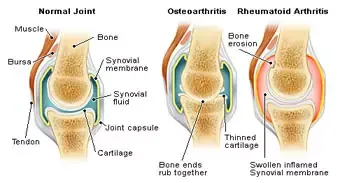Arthritis
is a common term that refers to various rheumatic diseases that can cause pain,
stiffness, and swelling in the joints, additional connective tissues, as well
as nerves. These diseases can also affect supporting structures such as
muscles, tendons, ligaments, and other parts of the body. Some common types of
arthritis are below:
1:Osteoarthritis
2:Rheumatoid
arthritis
3:System
Lupus Erythematosus
4:Gout
5:Ankylosing
Spondylitis
6:Psoriatic
arthritis
Osteoarthritis,
which is very common, is also referred to as degenerative joint disease
(especially when it occurs in the spine). It occurs when bone-on-bone surfaces
become irregular. Imagine a tight, high-pitched door joint, where the surface
of the joint has become rough otherwise maybe a bit marked. Osteoarthritis may
involve any joint; however, large joints such as the hip or knee and small
joints in the fingers are often involved. After age 30, almost everybody has
some kind of x-ray indication of osteoarthritis, thus it is easy to perceive
why it is recurrently diagnosed for aches and pains.
Many
people who have x-ray results of arthritis have no pain at all besides others achieve
full relief of their pain by treating related to non-arthritic disorders.
No
matter what that can affect how the joint otherwise joint functions can also
cause pain that feels similar to coming from the joint. When these sources are external
of the joint they are called extra-articular sources of pain. Illustrations consist
of a loose joint pin (the ligaments that hold the joint together are weak), an
irritated nerve that supplies the joint, a joint that is blocked (the joint is
subluxated), otherwise a joint that closes.
Arthritis
doesn’t have to become not as good as if you pay attention to the joint. By handling
and treating all of the structures that surround otherwise affect the joint;
both pain relief besides prevention are conceivable. One modest method is to provide
the joint freedom of motion by stretching muscles that are tight otherwise
inhibited around the joint and strengthening both the muscles besides ligaments
around it.
If a
nerve is irritated, then the muscles that are supplied by it will go into spasm
and stiff. In this case, stretching provides short-term relief and the nerve
irritation must be treated medically to provide lasting relief. Proper nutrition
and disease management are very important too, as optimal wound healing cannot
occur without it.
Treatment:
Injections
may be used to reduce inflammation of the joint or associated nerve, reduce
muscle spasm, stiffness, and to regenerate the ligament. If the joint itself is
badly arthritic, an injection of artificial cartilage to help lubricate the
joint or natural growth stimulating factors can also be effective. Most of
these treatments are along with proper and regular exercises, anti-inflammatory
medicines, as well as physical therapy. Regular exercises are very important to
reduce stiffness and relief pain in the body. Pain management is doing an important
role in this regard but it needs awareness. A proper campaign should be
requiring.
In
the most severe cases, joint replacement surgery may be required (In some
severe cases it required total hip replacement surgery). If you have
non-osteoarthritis rheumatism, then medical management directed toward stopping
inflammation is important as well. In any instance, treating extra-articular
structures provides more options for people with pain, weakness, or functional
impairment from arthritis, regardless of its form.
Source:
Pain.com








0 Comments
Dear Visitors: Please do not enter any spam link in the comment box. Thank you!